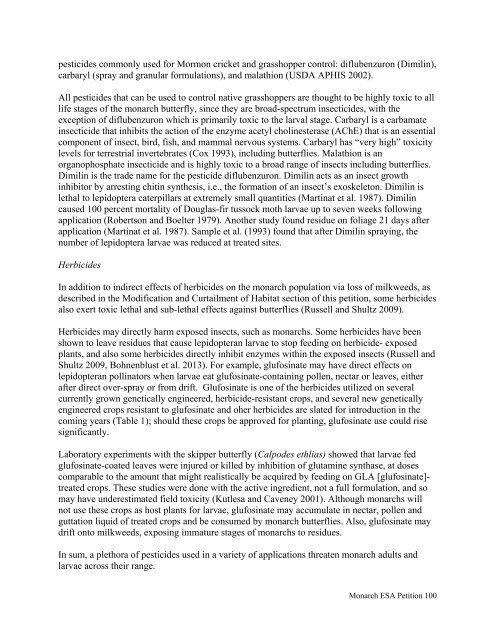monarch-esa-petition-final_61585
monarch-esa-petition-final_61585
monarch-esa-petition-final_61585
You also want an ePaper? Increase the reach of your titles
YUMPU automatically turns print PDFs into web optimized ePapers that Google loves.
pesticides commonly used for Mormon cricket and grasshopper control: diflubenzuron (Dimilin),<br />
carbaryl (spray and granular formulations), and malathion (USDA APHIS 2002).<br />
All pesticides that can be used to control native grasshoppers are thought to be highly toxic to all<br />
life stages of the <strong>monarch</strong> butterfly, since they are broad-spectrum insecticides, with the<br />
exception of diflubenzuron which is primarily toxic to the larval stage. Carbaryl is a carbamate<br />
insecticide that inhibits the action of the enzyme acetyl cholinesterase (AChE) that is an essential<br />
component of insect, bird, fish, and mammal nervous systems. Carbaryl has “very high” toxicity<br />
levels for terrestrial invertebrates (Cox 1993), including butterflies. Malathion is an<br />
organophosphate insecticide and is highly toxic to a broad range of insects including butterflies.<br />
Dimilin is the trade name for the pesticide diflubenzuron. Dimilin acts as an insect growth<br />
inhibitor by arresting chitin synthesis, i.e., the formation of an insect’s exoskeleton. Dimilin is<br />
lethal to lepidoptera caterpillars at extremely small quantities (Martinat et al. 1987). Dimilin<br />
caused 100 percent mortality of Douglas-fir tussock moth larvae up to seven weeks following<br />
application (Robertson and Boelter 1979). Another study found residue on foliage 21 days after<br />
application (Martinat et al. 1987). Sample et al. (1993) found that after Dimilin spraying, the<br />
number of lepidoptera larvae was reduced at treated sites.<br />
Herbicides<br />
In addition to indirect effects of herbicides on the <strong>monarch</strong> population via loss of milkweeds, as<br />
described in the Modification and Curtailment of Habitat section of this <strong>petition</strong>, some herbicides<br />
also exert toxic lethal and sub-lethal effects against butterflies (Russell and Shultz 2009).<br />
Herbicides may directly harm exposed insects, such as <strong>monarch</strong>s. Some herbicides have been<br />
shown to leave residues that cause lepidopteran larvae to stop feeding on herbicide- exposed<br />
plants, and also some herbicides directly inhibit enzymes within the exposed insects (Russell and<br />
Shultz 2009, Bohnenblust et al. 2013). For example, glufosinate may have direct effects on<br />
lepidopteran pollinators when larvae eat glufosinate-containing pollen, nectar or leaves, either<br />
after direct over-spray or from drift. Glufosinate is one of the herbicides utilized on several<br />
currently grown genetically engineered, herbicide-resistant crops, and several new genetically<br />
engineered crops resistant to glufosinate and oher herbicides are slated for introduction in the<br />
coming years (Table 1); should these crops be approved for planting, glufosinate use could rise<br />
significantly.<br />
Laboratory experiments with the skipper butterfly (Calpodes ethlias) showed that larvae fed<br />
glufosinate-coated leaves were injured or killed by inhibition of glutamine synthase, at doses<br />
comparable to the amount that might realistically be acquired by feeding on GLA [glufosinate]-<br />
treated crops. These studies were done with the active ingredient, not a full formulation, and so<br />
may have underestimated field toxicity (Kutl<strong>esa</strong> and Caveney 2001). Although <strong>monarch</strong>s will<br />
not use these crops as host plants for larvae, glufosinate may accumulate in nectar, pollen and<br />
guttation liquid of treated crops and be consumed by <strong>monarch</strong> butterflies. Also, glufosinate may<br />
drift onto milkweeds, exposing immature stages of <strong>monarch</strong>s to residues.<br />
In sum, a plethora of pesticides used in a variety of applications threaten <strong>monarch</strong> adults and<br />
larvae across their range.<br />
Monarch ESA Petition 100




